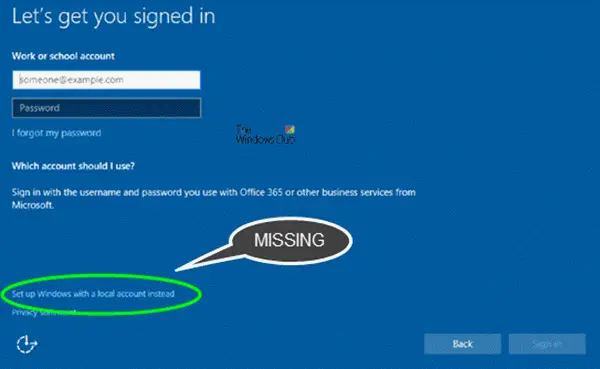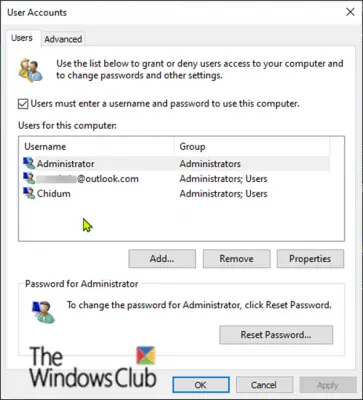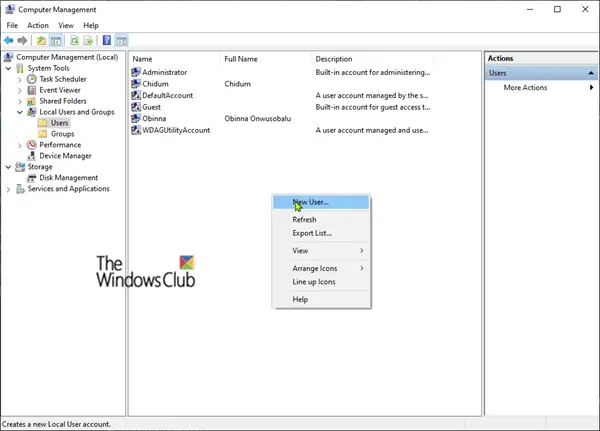Even though it is always recommended to log in to your computer using a Microsoft Account, at times, one needs to sign in using a Local User Account and Microsoft has provided an option to do so. However, we noticed that the Sign in with local account instead option is missing.

In today’s post, we will guide you through the steps to help you restore this option. This post can also assist you if you encounter a “Sign in with Microsoft account instead” message, or if you want to sign in without a Microsoft account.

Sign in with local account instead option missing
Before we go ahead and try to resolve this issue, we would recommend you check our post on how to change your Microsoft account to a Local account if you were trying to log in during the setup process of your computer. If the Sign in with local account instead option is missing in the Settings > Account > Your info page, go to the troubleshooting guide.
How to effectively resolve this issue depends on two scenarios.
First, you’ll need to open Advanced User Accounts Control Panel to check if the Local user account exists or not. Here’s how:
- Press the Windows key + R.
- In the Run dialog box, type netplwiz and hit Enter key.
- You’ll receive the output as shown below.

As you can see above, I have three user accounts listed: the built-in Administrator account, the Microsoft Account, and the Local Account.
Scenario 1
So with respect to the issue, we have at hand if the Local User Account is listed but the “Sign in with local account instead” option is missing, then it’s likely a case of corrupt Windows system files – in which case, you’ll need to attempt an SFC/DISM scan. Do the following:
Copy and paste the command below into Notepad.
@echo off date /t & time /t echo Dism /Online /Cleanup-Image /StartComponentCleanup Dism /Online /Cleanup-Image /StartComponentCleanup echo ... date /t & time /t echo Dism /Online /Cleanup-Image /RestoreHealth Dism /Online /Cleanup-Image /RestoreHealth echo ... date /t & time /t echo SFC /scannow SFC /scannow date /t & time /t pause
Save the file with a name and append the .bat file extension – eg; SFC_DISM_scan.bat
Repeatedly run the batch file with admin privilege (right-click the saved file and select Run as Administrator from the context menu) until it reports no errors – at which point you can now restart your PC and see if the option has been restored.
If the “Sign in with local account instead” option is still not available, then you can perform a Windows In-place repair upgrade. This procedure will retain all your installed apps, personalized settings, and personal files/documents – but will replace any corrupt or damaged system files with fresh copies.
Scenario 2
In the case of no Local User Account is listed in the User Accounts applet, that means the account hasn’t been created. So, you’ll need to create a Local User Account. Alternatively, you can create a new Local User Account in Windows 10 via the Computer Management snap-in console.
Here’s how:
- Right-click Start and select Computer Management.
- In the window, click the chevron on Local Users and Groups to collapse the section. Click Users.
- Now, right-click on the middle column and select New User.

- Follow the onscreen prompts to provide the new user details.
- When done, restart your PC.
The “Sign in with local account instead” option should now be available and you can be able to sign-in using the newly created Local User Account.
That’s it, folks. I hope this helps!
Related: Create a Local Account during or after installation of Windows Home.
How do I Sign in with a local account instead of Microsoft account in Windows 11?
To sign in with a local account instead of a Microsoft one, you need to go to Settings > Accounts > Your info. Now, you will have to click on Sign in with a local account instead. Finally, follow the on-screen instructions to set up your account.
Also Read: Benefits of using Microsoft Account in Windows.
Leave a Reply